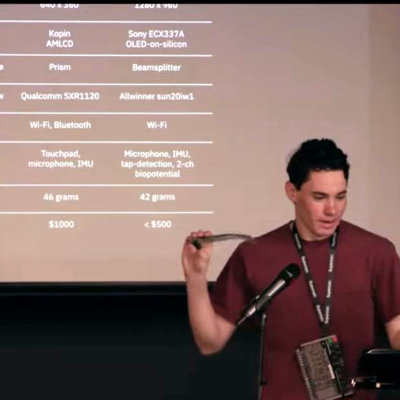
There’s something very tantalizing about an augmented reality (AR) overlay that can provide information in daily life without having to glance at a smartphone display, even if it’s just for that sci-fi vibe. Creating a system that is both practical and useful is however far from easy, which is where Aedan Cullen‘s attempt at creating what he terms a ‘practical augmented reality device’.
In terms of requirements, this device would need to have a visual resolution comparable to that of a smartphone (50 pixels/degree) and with a comparable field of view (20 degrees diagonal). User input would need to be as versatile as a touchscreen, but ‘faster’, along with a battery life of at least 8 hours, and all of this in a package weighing less than 50 grams.
Glass Elephant
When looking at Aedan’s glasses-based prototypes with the single-eye AR experience, it’s hard not to flash back to the Google Glass hype of the past, beginning in 2013 with the release of the Explorer Version 1. These ran Android 4.4, and featured a 640 x 360 Himax HX7309 LCoS display, a 5 MP camera, 1 GB of RAM (2 GB for version 2). Interaction with the user took place both via the touchpad on the side of the device, along with a voice interface.
Despite Google’s push behind the device and accompanying media hype, Google Glass as a consumer device was a flop, not in the least due to the rather off-putting $1,500 price tag , leading to it being retargeted to the commercial market with the Enterprise Edition in 2017 and Enterprise Edition 2 in 2019. In 2023 Google discontinued the $999 Enterprise Edition 2, but a March 2022 teaser promised a follow-up product with a less ambitious scope. Meanwhile Microsoft’s HoloLens appears to be solid tech, but also priced outside the comfort zone of consumers.
Finally, Apple is rumored to be on the verge of releasing their own AR glasses, which would run RealityOS, offer about eight hours of battery life, among a whole host of yet-to-be-confirmed features. Against this backdrop it’s interesting to consider what a hobbyist can tinker together in their own workshop.
Off-The-Shelf AR

To be clear, what Aedan is showing off in the presentation is not a ready-to-use device that can compete with whatever Google Glass did and what Apple’s AR glasses may or may not do if they ever end up being released. What his efforts do show off very clearly is that even with modest means, a hobbyist can use off the shell components like the Sony ECX337A OLED microdisplay to get a very compact, power efficient and high-resolution (1280 x 960) image source for an AR device.
From ther,e much of the effort was with finding a way to optimize power usage, as the original STM32MP1 with Linux running on the Cortex-A7 side was a bit too power hungry even during idle at 1 W. This led Aedan to a power sipping, presumably more affordable SoC in the form of the Allwinner D1-based sun20iw1 SoC. This features a single XuanTie C906 RV64GCV core on a 22 nm process, and should use less power than the STM32MP1.
In the current iteration of Aedan’s AR prototype, the PCB has moved from the typical bulge on the side as seen with Google Glass to a ‘shelf’ on the front, which makes it protrude more from the forehead but definitely improves the profile when viewing the wearer from the side. It is assumed that as the PCB is further shrunk down, the size of this protrusion can be reduced.
The hardware and its Linux OS is capable of supporting a wide range of interfaces, making it an interesting platform to tinker with, especially with the target price of less than $500 for the whole package. Aedan mentions looking into eye tracking, for instance.
As Aedan himself puts it, even if no usable product emerges from these efforts, for him the biggest return have been the valuable lessons learned from miniaturizing and optimizing such a compact design.
0 Commentaires